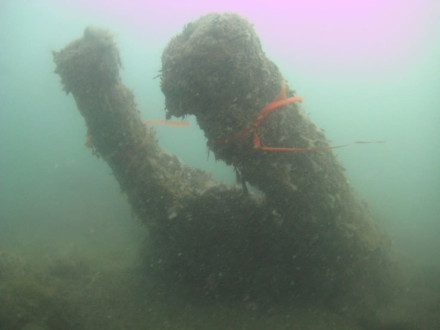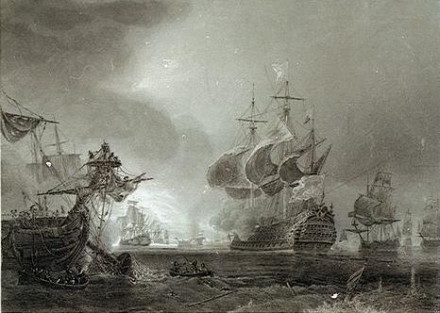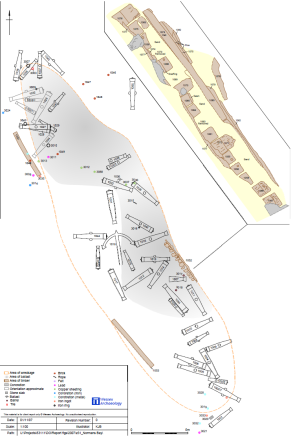History
Discovery
In 2005, three East Sussex divers stumbled upon a large pile of iron cannons in Normans Bay, whilst trying to free a lobster pot. Shortly after the discovery, surveys were carried out on the 'Normans Bay wreck' by Wessex Archaeology. Between the wooden ribs and planking of the ship, protruding from the seabed, they recorded three 24-pounder cannons, seven 12-pounder cannons, fifteen 6-pounder cannons and two 3-pounder cannons along with several that were too deeply buried or concreted to be measured.

The archaeologists also encountered a layer of uniform red bricks scattered around, along with various pieces of thin copper sheeting which may represent fragments of the ship's kettle. Taking the length of the visible remains as a guide, the vessel was estimated to have been approximately 40 m long, with a breadth of around 12 m. The ship's size and its armament clearly suggested that the ship was a 17th- or 18th century warship.

Possible identification
After its discovery, many believed the Normans Bay wreck to be the remnant of HMS Resolution - a 70-gun third rate warship that sank in the bay during the great storm of 1703. However, after dendrochronological analysis, the wood of the hull section appears to have originated in Germany or the Low Countries, with a felling date shortly after 1659. Although the Royal Navy could have imported the timber, it is thought to be more likely that the wreck is a Dutch ship.
Recorded losses in the area of Normans Bay indeed include several Dutch men of war, lost in 1690 in the Battle of Beachy Head. This battle was fought between an allied English and Dutch force against the French, during the Nine Years' War (1688 - 1697). Heavily outnumbered, the Dutch squadron under command of Cornelis Evertsen, quickly engaged in the attack, but found itself poorly supported by the English.
Although Evertsen managed to save much of his squadron by suddenly anchoring while under sail, causing the enemy fleet to be carried away with the tidal stream, the battle resulted in a crushing defeat, with heavy Dutch losses. Ten Dutch ships were lost in the encounter. Three of them were too small to be this wreck and three others were lost out to sea. There were three ships described as being beached near Hastings, which is six nautical Miles northeast of Normans Bay. This leaves the 64-gun Wapen van Utrecht as the most likely candidate. The description of the location where she was lost is a bit vague, but it could fit the bill.

Description
Involved institutions: Wessex Archaeology, English Heritage, Nautical Archaeology Society.

Status
The Normans Bay site, lying at a depth of 7 to 15 m, appears to be relatively stable, although some increased exposure of timbers has been noted in the southwest of the site. As part of the recording process in 2007, two steel survey pins used as a baseline for the post excavation plan have been left on location for sediment monitoring purposes. As the site also seems to be undisturbed by salvage attempts, it surely holds important information on 17th century warship technology. Even though the Normans Bay Wreck it hasn't been conclusively identified, it has been a protected wreck under the Protection of Wrecks Act (1973) since 14th June 2006.

References
- Wessex archaeology.
Norman's Bay Wreck. - Nautical Archaeology Society.
Normans Bay Wreck.